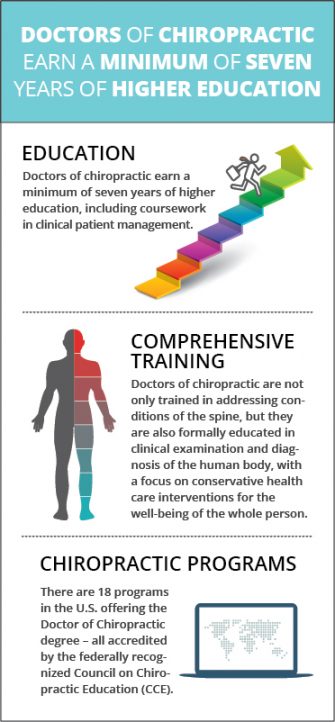Doctors of Chiropractic in U.S. Complete Seven Years Minimum Higher Education
Many Americans may be surprised to learn that doctors of chiropractic receive a minimum of seven years of higher education, including clinical patient management. The Foundation for Chiropractic Progress (F4CP), a not-for-profit organization dedicated to raising awareness about the value of chiropractic care, asserts that public perception regarding chiropractic education and training is seriously flawed and merits improved understanding among patients, families and health care decision-makers.
“Doctors of chiropractic are not only trained in problems dealing with the spine, but are formally educated in clinical examination and diagnosis of the entire human body, with a focus on health care interventions for the well-being of the whole person,” states Sherry McAllister, DC, executive vice president, F4CP, pointing to coursework included in the curriculum of a DC which addresses:
- Standards Foundation: principles; practices; philosophy and history of chiropractic
- Basic Sciences: anatomy; physiology; biochemistry; microbiology and pathology
- Clinical Sciences: physical, clinical and laboratory diagnosis; diagnostic imaging; spinal analysis; orthopedics; biomechanics; neurology; spinal adjustment/manipulation; extremities manipulation; rehabilitation and therapeutic modalities/procedures (active and passive care); toxicology; patient management; nutrition; organ systems; special populations; first aid and emergency procedures; wellness and public health; and clinical decision making
- Professional Practice: ethics and integrity; jurisprudence; business and practice management and professional communications
- Information Literacy and Research Methodology
Much of the development in chiropractic education stems from the establishment of accreditation efforts in 1938 that ultimately led to the
formation of the Council on Chiropractic Education (CCE). The U.S. Department of Education recognizes the CCE as the accrediting agency for educational and clinical programs leading to the award of the doctor of chiropractic (DC) degree. The CCE, a non-profit organization located in Scottsdale, AZ, sets standards for schools’ curriculum, faculty, facilities, patient care and research. All 18 programs in the U.S. offering the DC degree are accredited by the CCE. In addition, these programs are housed within educational institutions holding status with the respective regional accrediting bodies such as the Southern Association of Colleges and Schools (SACS) or the Western Association of Schools and Colleges (WASC).
“Chiropractic college programs are rigorous and thorough,” continues Dr. McAllister. “The vast majority of DC degree candidates entering their professional education hold a Bachelor’s degree and exceed the minimum three years of undergraduate study required for admission. Their chiropractic college education lasts four years, meaning they graduate with at least seven years of full-time university-level education. In their final year, students must also serve a clinical internship.”
Upon graduation and in order to practice in the U.S., individuals must pass comprehensive national and state licensing exams, similar to those for other professions.

Source: Foundation for Chiropractic Progress, www.f4cp.org